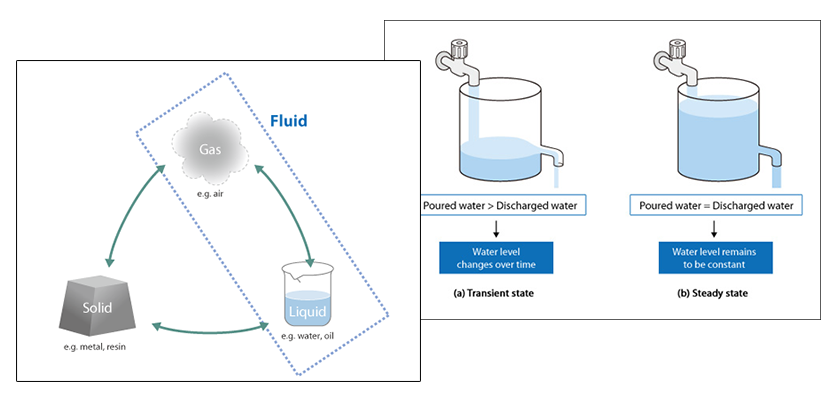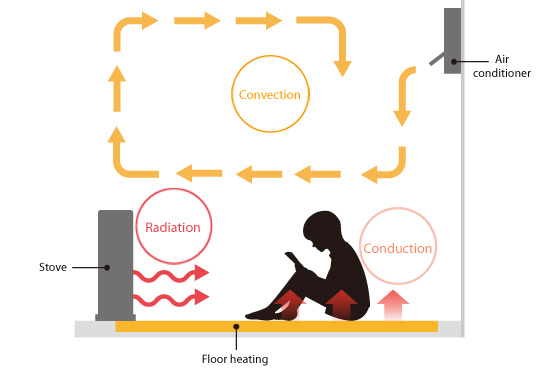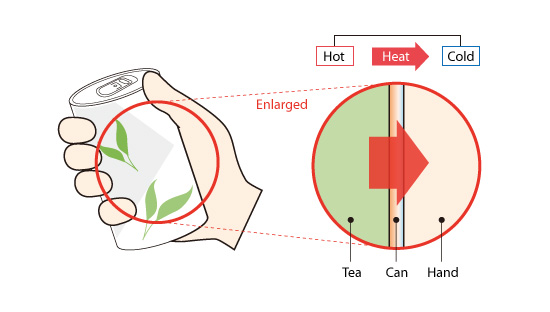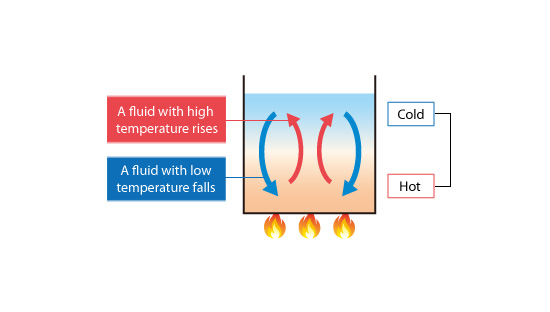Basic Course of Thermo-Fluid Analysis 10: Chapter 4 Basics of Heat - 4.4.1 Conduction, 4.4.2 Convection

Chapter 4 Basics of Heat II
4.4 Forms of heat transfer
There are three forms of heat transfer: conduction, convection, and radiation. Consider a room as shown in Figure 4.5. You will feel warmth where you contact the heated floor because of conduction. You will feel warm wind from the heating unit due to convection. You will feel warmth in front of the stove due to radiation. Each form of heat transfer will be explained in more detail below.

Figure 4.5: Form of heat transfer
4.4.1 Conduction
When the temperature in an object is uneven, the atoms and molecules (including the free electrons in metals) move within the object. Heat is transferred from the higher temperature region to the lower temperature region. This type of heat transfer is called thermal conduction.
For example, as shown in Figure 4.6, when you hold a can of hot tea, you feel the heat through the can. This is because heat is thermally conducted through the can due to the temperature difference between the hot tea and your cooler hand.

Figure 4.6 Heat transfer by conduction
Thermal conductivity is the property of a material that determines how much heat is transferred within an object. For two materials with the same initial temperature difference across them, the material with the higher thermal conductivity will reach a uniform temperature more quickly.
Heat conduction is a phenomenon that enables heat to be transferred within an object. Heat conduction can occur in solids, not only in fluids such as liquids, and gases.
4.4.2 Convection
In heat conduction, heat is transferred within an object. When the object is a fluid, heat can be transferred from the fluid to another object by flow of the fluid on the surface of the object. This type of heat transfer is called convection. Convection can transfer larger amounts of heat than conduction.
For example, as shown in Figure 4.7, when a container with water in it is heated, conduction heat transfer occurs within the water at the bottom of the container. In addition, the heated water rises due to buoyancy and convection occurs along the sides of the container, which leads to additional heat transfer.

Figure 4.7: Heat transfer by convection
The heat transfer coefficient expresses the amount of heat transferred between a fluid (either a liquid or gas) and a solid surface by convection. Heat can move from the fluid to the surface or vice versa. The heat transfer coefficient depends on a kind of fluid, its flow state, and the shape of the object. The larger the heat transfer coefficient, the more heat transfer occurs.
In general, the larger the thermal conductivity for a fluid, the larger the heat transfer coefficient. Therefore, the heat transfer coefficient for a liquid is higher than that of a gas.
For example, you can enjoy a sauna with an air temperature of 100 °C, but you cannot enjoy a bath with a water temperature of 100 °C. This is because the heat transfer coefficient of water is higher than that of air. The liquid water will transfer more heat to your skin than the air in the sauna. As a result, you will feel much hotter in the water than in the air.
Another factor that greatly influences the magnitude of the heat transfer coefficient is the fluid flow velocity over the object surface. The higher the velocity, the larger the heat transfer coefficient. Therefore, the heat transfer due to forced convection is larger than that of natural convection. The strong breeze from an electric fan will cool you faster than when no fan is present.

About the Author
Atsushi Ueyama | Born in September 1983, Hyogo, Japan
He has a Doctor of Philosophy in Engineering from Osaka University. His doctoral research focused on numerical method for fluid-solid interaction problem. He is a consulting engineer at Software Cradle and provides technical support to Cradle customers. He is also an active lecturer at Cradle seminars and training courses.


